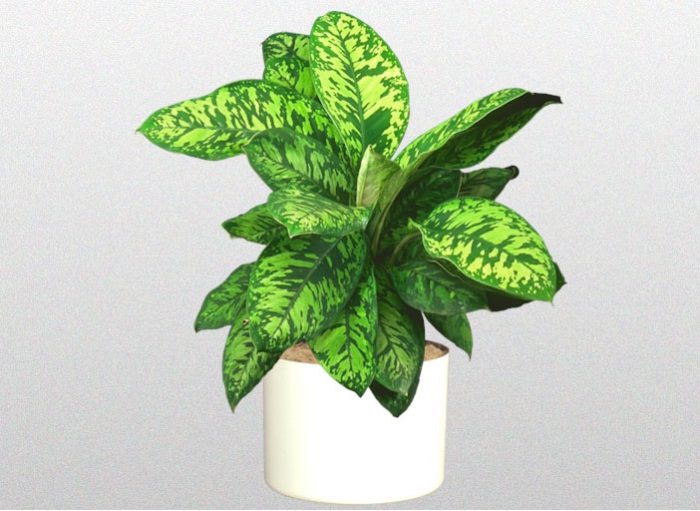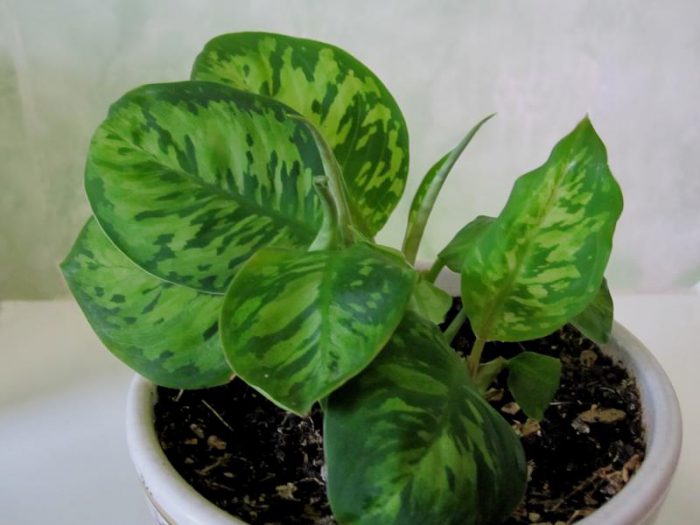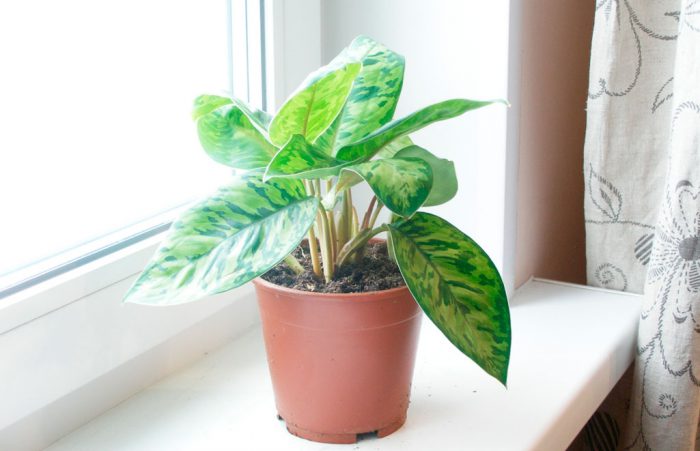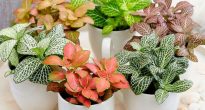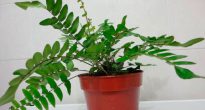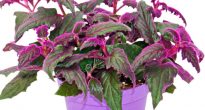Kind of like homomene, which is also called Homalomena, is directly related to the Araceae family. This genus includes about 150 species of various plants. They are found naturally in the tropical regions of America and Asia.
This plant has large basal rosettes, consisting of long-petiolate leaves. It has a well-developed powerful root system, due to which homolomena grows very much.
Leathery leaves have solid margins and often have distinct venation. As a rule, they are heart-shaped, but in different species it may vary slightly. Tiny, white-green flowers have no perianth. They are collected in a very dense inflorescence-cob, which is surrounded by a greenish veil.
Due to the fact that the homolomens found in nature do not differ in their decorative effect, various hybrids and varieties are often grown in indoor conditions. The most popular is Harlequin, which is a variety of Homalomena wallisii. This decorative deciduous plant grows rather slowly and has small, curved, red petioles. Dense, oval-shaped leaves reach 15 to 20 centimeters in length. An unusual pattern flaunts on the surface of the matte and velvety leaves: various pale green strokes, specks, and dots are scattered over the entire surface, which has a dark green-olive color. With age, the color of the leaves becomes brighter, and the velvety becomes more pronounced.
Content
Home care for homalomen
As a rule, this plant can be found infrequently at home. It is not very popular with flower growers. But Homalomen will definitely appeal to those who are a dieffenbachy lover. The fact is that such a plant is very similar to the cut off and rooted top of the latter.
Illumination
This is a fairly light-loving plant, but it should be borne in mind that it requires extremely diffused light. If the direct rays of the sun fall on the foliage, then it will turn yellow. And if you put it in a shaded place, then growth will slow down significantly, and bright saturated colors will become faded.
It is recommended to place it on the windowsill of an east or west window. If you put it in the southern part of the room, then the plant will definitely need to be shaded from the direct midday rays of the sun.In the northern part of the room, there will be no light, and there the homalomen will need to be illuminated with a special phytolamp.
Temperature regime
Loves warmth very much. It is recommended to keep this plant at a temperature of 21-27 degrees all year round. In the summer, it can be moved to fresh air, but you need to choose a place protected from precipitation and direct sunlight.
How to water
Water must be abundant. The soil should be slightly damp all the time. However, overflow should be avoided, as this can lead to acidification of the soil, which contributes to the emergence and development of rot.
Humidity
You need high humidity. So, in the warm season, it will be necessary to spray the plant 2 times a day (preferably in the morning and evening). To do this, you need to use extremely soft water (it is better if it is boiled). In winter, when the air in the heated room is very dry, additional methods of air humidification will be needed. So, you can pour expanded clay or large pebbles into the pallet and pour in a little water, and put vessels with liquid next to the flower. Another way is to use a household steam generator.
Earth mix
A soil mixture suitable for a given plant should be slightly acidic and light, and humus must also be present in it, and in large quantities. For planting, you can buy a ready-made mixture for aroids in a special store. If you wish, you can cook it yourself by mixing leafy and coniferous soil, coarse sand and high moor peat, taken in equal proportions. Don't forget a good drainage layer. He will be able to prevent stagnation of water in the soil and thereby protect the plant from the occurrence and development of rot.
Fertilizer
It is necessary to feed the plant all year round, but at the same time fertilizers are applied to the soil quite rarely, only once every 2 or 3 months. To do this, use a solution of complex fertilizer for aroid or decorative deciduous plants.
Transplant features
Homalomen should be transplanted only if necessary, for example, when the root system ceases to fit in the pot. You can transplant at any time of the year that is convenient for you, however, experts recommend doing this in the spring before the period of active growth begins.
Reproduction methods
This flower can be propagated by dividing its rhizome during transplantation, or you can use daughter sockets for this. You can share an already adult, highly overgrown plant. It is freed from the ground and then, using a very sharp knife, the rhizome is cut into pieces. It should be borne in mind that each delenka must have developed roots. After that, you need to process the cuts with chopped charcoal and plant the bushes in separate pots.
Daughter outlets must be carefully separated from the parent plant and then placed in a container of water for rooting. After the roots are formed, the sockets are planted in pots.
Pests and diseases
The spider mite most often settles. In order to get rid of it, you need to treat all the foliage with special chemicals (for example, actellik, fitoverm, etc.).
Possible problems
- The foliage turns yellow, yellow spots appear - overly intense lighting.
- It grows very slowly and the foliage is rather small - small pot or lack of nutrients.
- The aged leaves on the bottom dry and fall off Is a natural process.
- The tips of the leaves dry - low air humidity.
- Loose leaf rosette, weakened faded leaves - little light.
- The foliage turns yellow and the base of the petiole rots - the land is constantly waterlogged.

